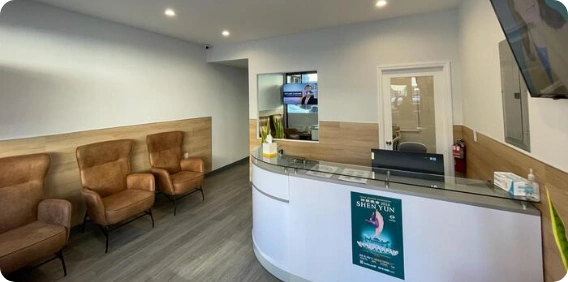Comprehensive Primary Care Services
& Physicians in NYCWalk-In & Same-Day Appointments
Personalized, Patient-Focused Primary Care at Manhattan Medical Arts
Looking for a trusted primary care doctor near me who truly cares about your long-term health? At Manhattan Medical Arts, our board-certified primary care physicians (PCPs) deliver high-quality, personalized medical services, helping you stay healthy and manage both acute illnesses and chronic conditions.
With years of combined experience, state-of-the-art technology, and a compassionate team led by Dr. Syra Hanif, we provide healthcare solutions that are tailored specifically to your needs.
Our approach goes beyond simple treatment — it’s about building lasting partnerships focused on prevention, early detection, and achieving better health outcomes through evidence-based care.
Why Choose Us for Your Primary Care
in Manhattan?

Board-Certified Physicians
Experienced, highly-trained doctors dedicated to providing personalized and preventive healthcare at every stage of life.

Convenient Locations Across NYC
Our medical clinics in NYC — located in Manhattan and Forest Hills — are easily accessible, helping you get care close to home or work.

Same-Day and Telehealth Appointments
Busy schedule? We offer flexible booking options, including same-day visits and secure telemedicine consultations.

State-of-the-Art Medical Facilities
Our advanced diagnostic equipment allows for rapid testing, accurate diagnoses, and timely treatments — improving your health outcomes faster.

Holistic Health
Approach
We emphasize preventive care, wellness education, and lifestyle support — because great healthcare starts before problems arise.
Searching for a doctor near me you can count on?
Our team makes it simple to stay ahead of health issues with proactive primary care.
We Offer Comprehensive
Primary Care Services
Annual Wellness Exams
Stay on top of your health with routine check-ups.
Chronic Disease Management
Expert care for diabetes, hypertension, asthma, COPD, and high cholesterol.
Preventive
Care
Vaccinations, cancer screenings, and personalized health plans.
Acute Illness Treatment
Fast diagnosis and treatment for infections, colds, flu, and other common conditions.
Men’s and Women’s Health
Reproductive health, prostate care, and hormone management.
Geriatric
Care
Senior-focused healthcare for improved well-being.
Mental Health Support
Anxiety and depression screenings with referrals to specialists.
Minor Injuries Treatment
Sprains, cuts, minor burns, and wound care.
Need urgent care? Schedule your appointment today Here
Conditions We Treat at
Manhattan Medical Arts
Our general practitioner nyc team specializes in diagnosing, treating, and managing a wide range of health conditions, including:

Chronic
Conditions
Diabetes, hypertension, asthma, COPD, and high cholesterol.

Minor
Injuries
Sprains, cuts, minor burns, and wound infections.

Mental Health
Concerns
Basic management of anxiety, depression, and stress.

Endocrine
Disorders
Thyroid disorders and hormonal imbalances.
Meet Our Physicians

Primary Care Physician
A board-certified family medicine physician affiliated with NYU Langone Medical Center, Dr. Hanif brings years of experience in preventive medicine, chronic disease management, and patient advocacy.

Cardiologist
A highly respected New York native and cardiac care specialist.

Child and Adult Psychiatrist
Compassionate, patient-centered mental healthcare specialist.

Family Medicine Specialist
Experienced in comprehensive family healthcare, preventive medicine, and chronic condition management.

Akeilia Thompson
Adult Nurse Practitioner

Crystal Chung
Physician Assistant
Choosing a private medical practices near me clinic like Manhattan Medical Arts means trusting your health to a team that’s dedicated, compassionate, and results-driven.
Our Locations
In NYC

Manhattan Location

Forest Hills Location
Whether you’re searching for a pcp office near me or looking for trusted medical care you can depend on,
ur clinics are here to serve you.
Book Your Primary Care
Appointment Today!
Finding the right primary care physician in NYC is essential for long-term health.
Schedule an appointment today and experience compassionate, patient-centered healthcare at Manhattan Medical Arts.
Frequently Asked Questions
What is Primary Care?
Primary care is comprehensive health management that focuses on prevention, early diagnosis, and treatment of common illnesses and chronic diseases. A primary care provider serves as your main healthcare partner, guiding you to specialists when needed.
What is a primary care physician (PCP)?
A PCP is a general practitioner trained to offer a full range of health services — from preventive care to chronic disease management — acting as your first point of contact for any medical concern.
How often should I see my primary care doctor?
According to the CDC, annual wellness exams are recommended for all adults, even if you feel healthy. Patients managing chronic conditions should visit more frequently based on individual care plans.
Do you accept insurance for primary care services?
Yes! We accept most major insurance plans to ensure healthcare is accessible for our community.
Can I get a same-day or telehealth appointment?
Absolutely. We offer same-day in-person and virtual consultations for your convenience.
What should I bring to my primary care appointment?
Bring your ID, insurance card, medication list, and any important medical documents that might help us personalize your care plan.
Quick Health Tip:
Early screenings can reduce your risk of serious illness by up to 40%, according to the CDC.
Don’t wait until symptoms get worse — prevention starts with a simple check-up!
Latest Blog Posts
Making primary care accessible













